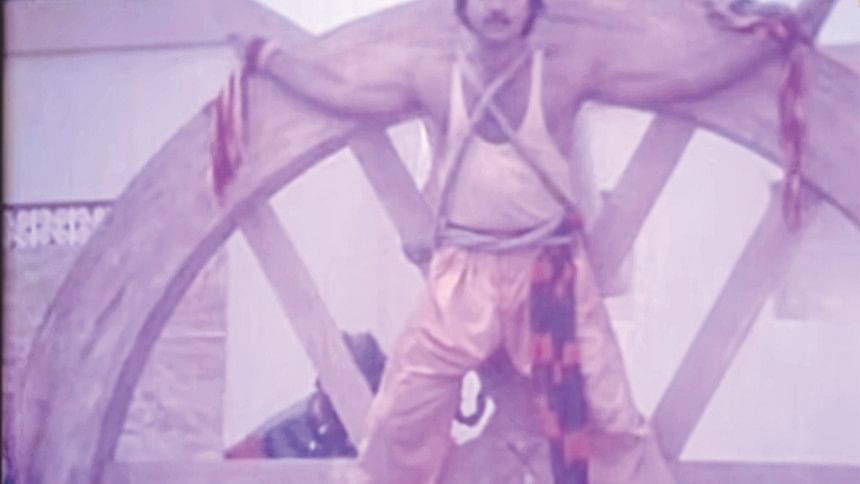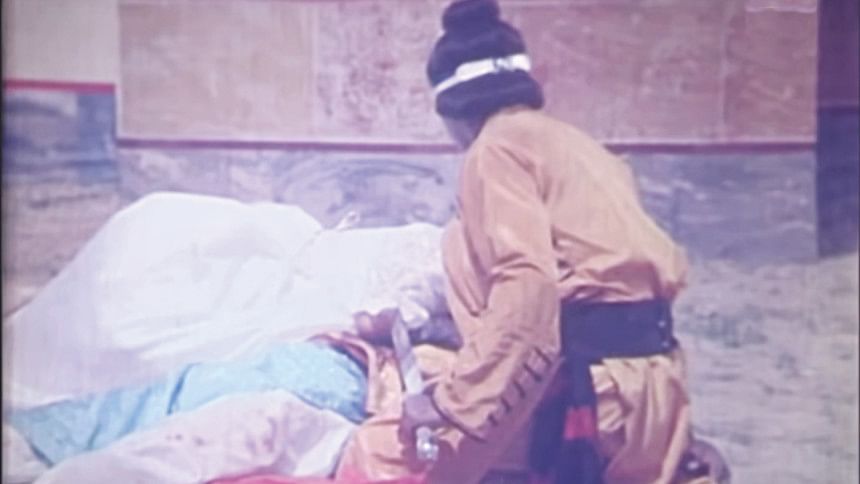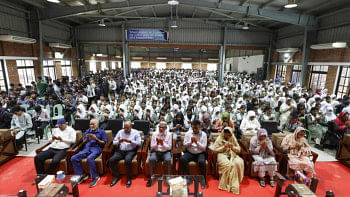The case for BOJROMUSHTI

For the longest time, I used to be of the opinion that the only value old, mainstream Bangladeshi cinema had was in ironic viewing. B movies of the past enjoy a sort of immortality online in the form of memes. In fact, Bangla movie stills make up a large part of the local content we see online. The grittiness of degraded film stock, tinny audio, costumes, and the sheer absurdity (at times vulgar) packed into the worn out formula of Bangla cinema shares all these characteristics with cult film theory in the West. While these characteristics don't necessarily make Dhallywood productions "cult", they certainly portray elements of the potential of something worth exploring, if we were to simply view some of the less acclaimed parts of our film history through a different, modern lens.
Around a month ago, YouTube channel ButtFiXx made a 1989 Dhallywood movie, Bojromushti (translated to ThunderFist) very popular online and has found its way into the memes of the week. While I didn't end up watching the ButtFiXx video, the stills used in memes piqued my interest. Especially the fact that the movie managed to toe the line of making a Chinese martial arts movie without being outright racist with its colourful approach to costume design back in a world that didn't care as much about racism. That being said, the movie has its sexist moments, but I think it's fair to assume you already expected as much.

The plot revolves around the pupils of a martial arts master and opens with their graduation from his training. However, the master has only taught them the ways of one chapter of the ancient text and when asked why, he responds by saying that is all that one needs for self-defense and saving the lives of others. The other two parts being far too aggressive and powerful for regular humans. He secretly entrusts the book to one of the students and shortly dies after. But of course, our villain for this story, one of the other students, is hell-bent on getting his hands on the book. Doesn't sound half bad. Sure, it's not original in the wider world of movies, but for the 80s in Bangladesh, it's something new. The plot is made all the more funnier by the fact that all four students look like they're pushing well into their 50s at the time of their graduation.
The rest of the movie is spent behind how one of the students (it really doesn't matter what any of their names are) slowly picks off martial artists around the land, including his classmates, in search of the book. When fights break out in the middle of spacious fields and hills with men clad in colourful robes, set against the degraded VHS look, it's hard not to draw comparisons to watching the Namek episodes of Dragonball Z. While that might not sound appealing, the internet has carved out a niche for this "look" in movements such as vapourwave or synthwave, and I for one welcome our version of Kung Fury (2015) with open arms.
Where Bojromushti excels in is (surprisingly) action and pacing. My usual gripe with action scenes in these kinds of productions from the region is that they're all the same. The fight choreography isn't the best, but it's a step above the pack on the merit of being simply different and holds its own against some of our more contemporary movies. And similar to the aforementioned Dragonball Z, half of the fight scenes are actually spent fighting while the other fifty percent consists of overly exaggerated taunts. Sometimes even devolving into two men just imitating the sounds of any given Jackie Chan movie while they flail their limbs around in preparation for something that never quite comes. The hero of the action scenes doesn't come from well-choreographed Jason Bourne-esque fights, but it is found in the comedic timing. So often we'll find ourselves laughing only at the "it's so bad it's funny" moments, but throughout a large chunk of Bojromushti it becomes very apparent that the comedic timing is done with purpose and a determined hand. While the action sort of gets a pass due to a low bar set, the pacing is truly something great for three quarters of the two and a half hour run time. The pace is quick, fights never overstay their welcome on screen, and the small number of songs, though excruciatingly long, is a merciful count for deshi movies.
As we continue to live in an ever increasing post-postmodern culture and mediascape, our criteria for entertainment changes. Upon watching the movie, I can't see many people from the 80s enjoying it when it was released. As a standard movie, it doesn't hold up. But for millenials and Gen Z, the context with which we go into consuming content and media has changed so much since our forefathers. As seen with meme culture, the youth of today are perfectly capable of extracting their own versions of entertainment and takeaways from the content they experience due to such a wide net of context we have, thanks to the Internet.
Changing our lens or the way we approach something and opening ourselves to new forms of content and creativity can turn a dud into something worth experiencing. Bojromushti isn't perfect. It's not even particularly very good. However, certain images are stuck in my mind and there are parts that I loved and laughed at. In a world where pretty much all kinds of productions are polished for edges and sterile, to enjoy something simply for what it is, is a rare pleasure that cult, B-grade movies act as a safe haven for.
Talat Ahmed is a sub-editor at SHOUT. Find him on Instagram @talatxhmed.

 For all latest news, follow The Daily Star's Google News channel.
For all latest news, follow The Daily Star's Google News channel. 



Comments